The Basics of Print Reciprocal Dividers/Combiners
Leo G. Maloratsky
Rockwell Collins, Air Transport Systems
Melbourne, FL
A reciprocal divider can provide an equal or unequal power split between two or more channels. Because of their reciprocity, these networks may also be employed to combine the power of a number of oscillators or amplifiers at a single port. Dividers and combiners are used in feed networks in antenna arrays, balanced mixers, high power transmitters, balanced amplifiers and test instrumentation.
The most important characteristics of power dividers (combiners) are power split ratio, isolation, insertion loss, matching, phase balance and bandwidth. Divider power split ratio or power division ratio m is calculated as the ratio of power at the output ports when all ports are terminated by nominal (reflectionless) terminations. The divider can be configured with an equal (m = 1) or unequal (m ? 1) power split.
Isolation is calculated as the ratio in decibels of power between the output ports (for divider) or input ports (for combiner) when all ports are terminated by reflectionless terminations. Is
olation depends on the structure of the device, termination mismatching, losses, discontinuities and manufacture tolerances. Phase balance is the relative phase difference of the output waves. Quadrature (90°), in-phase (0°) and out-of-phase (180°) devices are most popular. The relative phase difference depends on the divider type application.
T-JUNCTIONS
The simplest printed single-layer three-port divider is analogous to coax and waveguide T-junctions.1 It can have a series or parallel connection of one input and two outputs. In the parallel planar connection, the signal splits in-phase between two outputs. In the series planar connection, it splits out-of-phase. Various power division ratios can be provided by selecting the appropriate output impedances. The power split is inversely proportional to the output impedance ratio.
Some useful multilayer T-junctions with different input and output transmission lines are shown in Figure 1 . Case a is where the input transmission line is a microstrip line (ML) and the two output lines are nonsymmetrical slotlines (SLL), which are realized on two sides of the dielectric substrate. The slotline arms and microstrip arm are connected in parallel to each other.

The T-junction of case b includes a bottom slotline open circuit through a nonuniform circular slotline and microstrip line on the top substrate side. The microstrip arms and slotline arm are connected in series to each other.
Case c shows a T-junction between the input microstrip line with quarter-wavelength open stub and output coplanar waveguides (CPW). In the center of the junction, the center conductor of the CPW has a via-hole.
The T-junction of a symmetrical and two nonsymmetrical slotlines is displayed in case d. Case e shows the coplanar waveguide-microstrip T-junction with quarter-wavelength CPW open stub.
The simple three-port network structure of T-junctions has two significant drawbacks: absence of isolation between output ports and imperfect matching of all ports. Theoretically, the reciprocal three-port network without loss cannot be matched at all ports simultaneously. The power dividers/combiners discussed next are free of these disadvantages.
WILKINSON DIVIDER/COMBINER
The Wilkinson power divider2 provides matching of three ports, low loss, an in-phase split and high isolation between output ports. The simplest Wilkinson divider shown in Figure 2 consists of two transmission lines, which have a physical length l1 =l 0 /4 relative to the mid-band frequency of the divider (l 00 is the guide wavelength) and provides equal power division. The lumped resistor R2 is connected between outputs of the two quarter-wavelength lines.
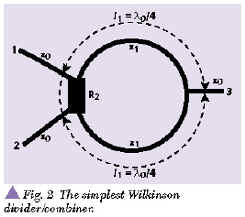
Perfect matching of all divider ports and perfect isolation between the first and second ports (at the center frequency) are obtained if

where
Y1 =z0 /z1
=normalized admittance of the line segments of length l1
z0 =characteristic impedance of the input (output) lines
Y2 =2z0 /R2
=twice the normalized admittance of resistor R2
The scattering matrix of the ideally matched Wilkinson divider at the center frequency is

Differing from no loss reciprocal T-junctions, the Wilkinson divider can be matched at all ports simultaneously because this three-port network uses a lossy element (resistor R2 ). The maximum isolation of the Wilkinson divider goes to infinity (see Equation 1). But the real divider characteristics deviate from ideal due to manufacture tolerances, losses, discontinuities and mismatching of the terminations, as well as the physical quality of the resistor. In reality, due to these destabilizing factors, isolation can vary between 15 and 30 dB. In a number of devices, a finite value of isolation is required. For example, in circuits for combining oscillator powers that are connected to isolated ports of a combiner, a definite value of isolation is required to provide mutual synchronization of the oscillators.
A combiner with fixed isolation can be realized3 by the Wilkinson circuit where resistor R2 ?2z0 is connected between ports 1 and 2. For this circuit, isolation between ports 1 and 2 becomes dependent on the resistor value. Relationships of isolation and matching vs. deviation of resistor admittance (D Y2 /Y2 ) x 100% are shown in Figure 3 .

Theoretically, this divider with the branch impedances z1 = z0 v2 provides the specified isolation, ideal matching of port 3 and no losses. However, ports 1 and 2 are mismatched, which is often unacceptable in some devices, such as oscillator power combiners, where good matching is required.
Previously published calculations showed3 that for the perfect matching of ports 1 and 2 for specified isolation it is necessary that Y1 =v2Y2 or z1 = 2z0 vz0 /R2 (W ) . For this network, the divider characteristics at the mid-band frequency are

These characteristics vs. normalized admittance deviation (D Y2 /Y2 ) ×100 percent are shown in the previous graphs.
Unequal power-split ratio (m ≠ 1) Wilkinson dividers1,4,5 are frequently employed in array antennas and different types of receivers. This divider consists of two quarter-wave segments 1-2 and 1-3 of different impedances z12 and z13 that realize the desired power division. The lumped resistor R2 provides the required isolation between output arms.
This unequal power-split ratio divider has normalized impedances and a lumped resistor5 determined by

In multichannel dividers and combiners, the connection of several Wilkinson power dividers is used, as shown in Figure 4 . The distance between dividers is l =l 0 /2. (l 0 is the guide wavelength at the connection line relative to the mid-band.) Figure 5 shows the circuit's frequency characteristics, as well as the frequency response of the single divider (dashed lines) for comparison.3 These characteristics show that matching of input/output ports of a three-divider network is more sensitive to frequency change than the matching of a single divider.


DIRECTIONAL COUPLER DIVIDERS AND COMBINERS
A directional coupler is a reciprocal four-port network, which provides two different amplitude outputs when a signal is applied to its input. This definition of a directional coupler speaks of its possible use for split power from one port between two other ports. The divider based on a ring directional coupler is shown in Figure 6 . Power P1 flows into port 1 and splits between ports 2 and 3. As a result, powers P2 and P3 are dissipated in corresponding terminations R2 and R3 . A matched ballast termination R5 is connected to port 4 to which, theoretically, there is no flow of power. (In practice, there is a significantly diminished power flow.) This termination is ballast only from a structure point of view; functionally, it is essential, with a precise optimum value, to ensure proper performance of the network.
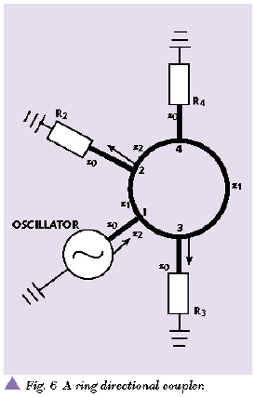
The normalized admittances are obtained using3

The scattering matrix of the ring divider is

As can be seen from Equations 2 and 3, the energy of source connected to one of the ports of the ring divider is distributed between the adjacent ports according to the square of the admittances ratio

If the power split for the two-branch divider shown in Figure 7 is specified at3

then the normalized admittances are equal3 such that

The scattering matrix of a two-branch divider is


The three-branch divider has larger bandwidth than the two-branch divider. Additional branches can expand the bandwidth even farther. However, dividers with more than four branches are difficult in microstrip because the end branches require higher impedances, which reach the upper limits of practical realization.6
The printed three-branch divider with power split regulation is shown in Figure 8 . It is the divider in which two reactances are connected with the center branch. These reactances can be realized as opened (as in the diagram) or shorted lines. If port 1 (or port 3) is the input, the power split between port 2 and port 4 depends on the length of open (or short) lines. For perfect matching at the mid-band frequency, the normalized characteristic admittances Y1 , Y2 , Y3 are given as5

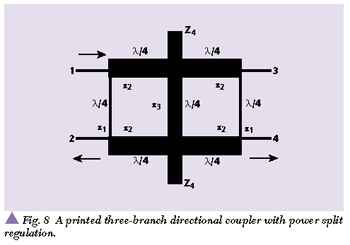
The important advantage of the branch dividers is achieving good input matching because reflected signals from identical outputs are absorbed in a ballast termination. In addition, the branch dividers/combiners are effective for planar fabrication of balanced circuits because the output ports from the network are on one side.
Ring and branch directional couplers can be used as combiners of a number of oscillators at a single port. Combining powers P1 and P4 of two oscillators is realized in a ring combiner, as shown in Figure 9 . Output termination R2 and ballast termination R3 are connected to the ring combiner. From the analysis of the scattering matrix of Equation 3 it follows that signals from two in-phase oscillators are in-phase at port 2 and out-of-phase at port 3. Power flowing into port 3 is zero when

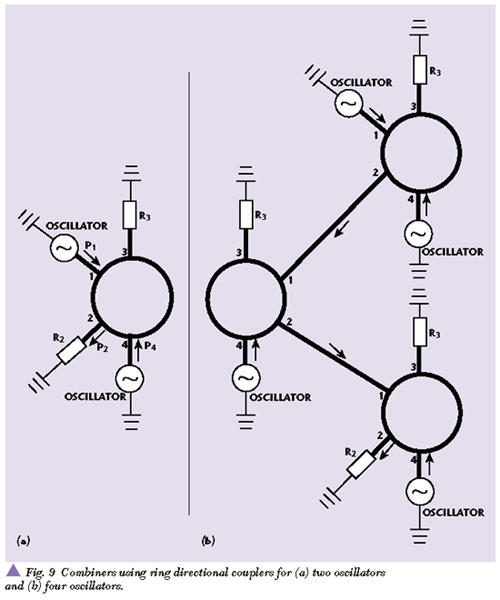
Power combining of more than two oscillators can be realized by a chain-like connection of ring combiners in which each consecutive ring combiner acts as a load for the preceding one, as shown in the diagram. The main condition for high efficiency combining of power in the common termination is the equality of different oscillator's frequencies and phases. These conditions can be satisfied by the mutual synchronization of oscillators using signals that leak through because of the imperfect coupler isolation. The coupler's imperfect isolation is caused by the mismatched terminations and manufacturing tolerances. Due to the uncontrolled variations of these parameters, it is difficult in practice to ensure constant coupling between oscillators. Thus, additional tuning is required to provide the optimum synchronizing signal which maximizes efficiency.
An example of this circuit is shown in Figure 10 . In this circuit, equal quadrature signals of two identical-frequency oscillators connected to ports 1 and 2 of a 3-dB two-branch coupler are combined. In the ideal case, the combined power appears only on port 3, while port 4 is isolated because signals at this port are out-of-phase. If any of above conditions (equal powers, phase quadrature and equal frequencies) are not satisfied, then an unbalanced signal appears in port 4.

A specified coupling between oscillators can be realized in the network. Due to the specially introduced mismatching element (short or open segment l4 of adjustable length), the unbalanced signal is reflected from the end of port 4 and travels into the two oscillators for mutual synchronization. Another possibility is to use an additional synchronizing oscillator connected to port 4.
Power combining of more than two oscillators can be realized, for example, by the network displayed in case b of the diagram. This network ensures power combining of four oscillators using three two-branch combiners. Line segments of length lI , lII , lIII performing the same functions as segment l4 , which are connected to port 4 of each two-branch combiner. Analysis of this network3 leads to the following conclusions. Scattering matrix elements S15 , S25 , S35 and S45 , which characterize voltage transmission coefficients from the corresponding oscillator to the load, are independent of mismatching of ports 4I , 4II and 4III . Reflection coefficientsG I , G II and G III of the adjustable segments connected to these ports determine only the coupling between oscillators. The mutual synchronization can be regulated by varying reflection coefficients G I , G II and G III . The given network also can be used for splitting the power of one source at port 3III .
A coupled-line directional coupler, shown in Figure 11 , can be used for broadband power division or combining. The edge coupled-line printed coupler cannot be manufactured for a power division m < 10 because of etching tolerances. For the ratio 1 < m < 10, the broadside coupled-line coupler can be used. The broadband Lange directional coupler7 is used for equal power division (m = 1). The scattering matrix of the ideally matched coupled-line divider can be derived from3

where

= electrical length of the coupled lines
» = guide wavelength
Z0e = normalized characteristic impedances for the even mode
Z0o = normalized characteristic impedances for the odd mode


Power dividers and combiners are frequently used in balanced circuits, for example in balanced amplifiers. Figure 12 shows a balanced amplifier using a coupled-line divider and combiner. The input signal is fed to the input of the quadrature divider. Half of it appears at either amplifier 1 or amplifier 2. Amplifier 1 operates in phase quadrature with respect to amplifier 2. After amplification, a quadrature combiner of the same type is used to combine the signals at the output port of the combiner. The isolated ports of the divider and combiner are terminated in 50 W resistors R1 and R2 . If the two amplifiers are identical and an ideal divider and combiner are used, then input and output matching should be ideal.

COMPARISON OF DIFFERENT DIVIDERS (COMBINERS)
Using Equations 1, 2, 4 and 5, normalized impedance values for different dividers having isolation of output ports are listed in Table 1 . The power split m = 3 is difficult to realize in Wilkinson, ring and branch dividers. The limiting factor here is the impossibility of manufacturing narrow printed conductors of high impedance segments. In addition, an increase in impedance and a corresponding decrease of the conductor width lead to increased losses.6 Table 2 lists performances of different printed reciprocal power dividers/combiners.
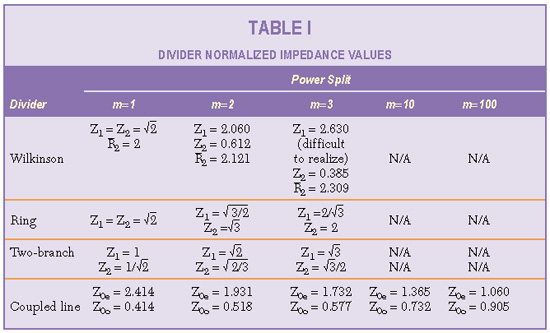

ACKNOWLEDGMENT
The author would like to thank Simon London who provided valuable suggestions. *
References
1. M.D. Pozar, Microwave Engineering , Second Edition, John Wiley & Sons Inc., 1998.
2. E. Wilkinson, "An Eight-Way Hybrid Power Divider," IEEE Transactions on Microwave Theory and Techniques , Vol. MTT-8, January 1960, pp. 116118.
3. L. Maloratsky, Microminiaturization of Microwave Elements and Devices , Soviet Radio, Moscow, 1976.
4. L.I. Parad and R.L. Moynihan, "Split-tee Power Divider," IEEE Transactions on Microwave Theory Techniques , Vol. MTT-16, February 1968, pp. 110116.
5. L. Maloratsky and L. Yavich, Design and Calculation of Microwave Elements on Stripline , Soviet Radio, Moscow, 1972.
6. L. Maloratsky, "Reviewing the Basics of Microstrip Lines," Microwaves & RF , March 2000, pp. 7988.
7. J. Lange, "Interdigital Stripline Quadrature Hybrid," IEEE Transactions on Microwave Theory Techniques , Vol. MTT-17, December 1969, pp. 11501151.
Leo G. Maloratsky received his MSEE from Moscow Aviation Institute and his PhD from Moscow Institute of Communication in 1962 and 1967, respectively. Since 1962, he has been involved in the research, development and production of microwave integrated circuits at Electrotechnical Institute and was an assistant professor at Moscow Institute of Radioelectronics. From 1992 to 1997, he was staff engineer at Allied Signal responsible for the design of microwave devices. In 1997, he joined Rockwell Collins where he works in RF and microwave integrated circuits for avionics systems.
